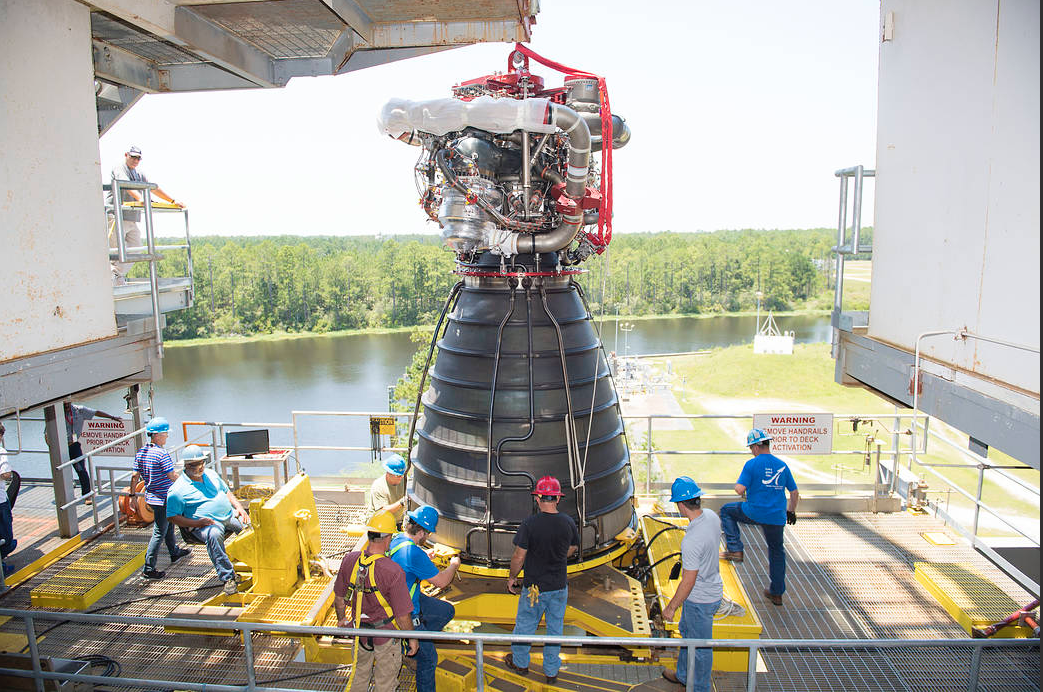
Two important milestones occurred at Aerojet's hot-fire test of an RS-25 development engine conducted with NASA Administrator James “Jim” Bridenstine in attendance.
The occasion was a hot-fire test of an RS-25 development engine where its main combustion chamber (MCC), the very heart of the engine, was fabricated using a bonding technique called hot isostatic pressing (HIP), an innovative manufacturing process that saves considerable time and money over more traditional methods. Initial test data indicates the chamber performed flawlessly during the 319-second test, which represents the anticipated SLS flight profile.
And another significant milestone is Aerojet Rocketdyne's efforts to reduce costs on the RS-25 engine that powers NASA’s new rocket, the Space Launch System (SLS), today at NASA’s Stennis Space Center.

RS-25 Engine Installed On Stennis Space Center Stand For New Test Series
Each SLS is powered by four RS-25 engines. Currently, the SLS program has 16 engines in its inventory remaining from the space shuttle, enough for four flights. New flight controllers are being made for these engines and today’s development engine tested another flight controller to certify it is ready for integration with a flight engine. Engines produced for later flights will incorporate additional manufacturing updates to reduce costs for certain parts of the engine.
Eileen Drake, Aerojet Rocketdyne CEO and president stated that as they develop a new generation of RS-25 engines, ensuring they continue to remain reliable while reducing costs is a major focus at Aerojet Rocketdyne. That’s why they’re working hard to drive down costs on the RS-25 by incorporating the most modern and efficient manufacturing techniques.
Aerojet Rocketdyne is under contract to manufacture an initial set of six new engines for future SLS missions. These new engines will be fabricated using the components and techniques that are being validated now on development engines at Stennis. The test today also marked the fifth successful demonstration of an additively manufactured Pogo Accumulator Assembly. The “Pogo” is a critical component that dampens potential engine propellant pressure oscillations that can cause a rocket to become unstable in flight. The 3-D printed Pogo, which is about the size of a beach ball, continued to perform as designed during the test series, bringing the promise of further RS-25 cost savings via additive manufacturing closer to reality.

Jim Bridenstine
A HIP-bonded MCC is the latest component developed under the new engine contract to enter hot-fire testing. The HIP-bonding technique employs high pressure and heat to create bonds between engine details that can withstand extremely high stress applications. In the case of the RS-25 MCC, where the engine’s “smoke and fire” initiates, that means withstanding combustion temperatures exceeding 6,000 degrees Fahrenheit and pressures over 3,000 psi.
Drake continued that the HIP-bonded MCC is the single largest affordability improvement being incorporated into the new RS-25 engines. It cuts in half both the cost and fabrication cycle time compared to the heritage Space Shuttle Main Engines. HIP bonding is also an extremely robust and predictable process, which greatly reduces process variation.
HIP-bonded combustion chambers are flying today on Aerojet Rocketdyne’s RS-68A engines, the booster engine for United Launch Alliance’s Delta IV satellite-launching workhorse. The process was also successfully validated during the J-2X upper stage and the X-33 Linear Aerospike engine development programs.
Drake added that they were incredibly honored to have Administrator Bridenstine witness an RS-25 engine and see first-hand the affordability initiatives they are undertaking with this engine and program.

